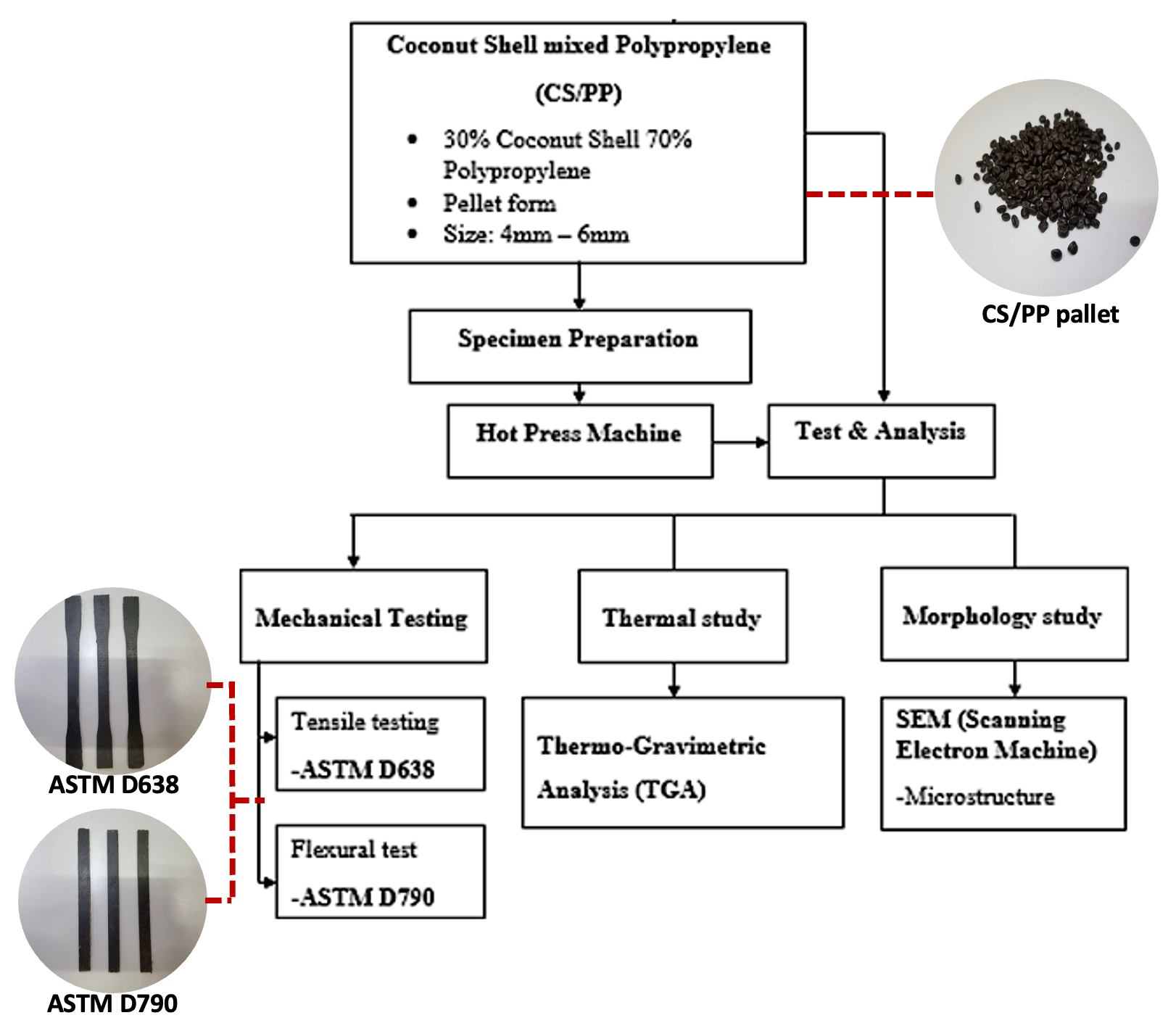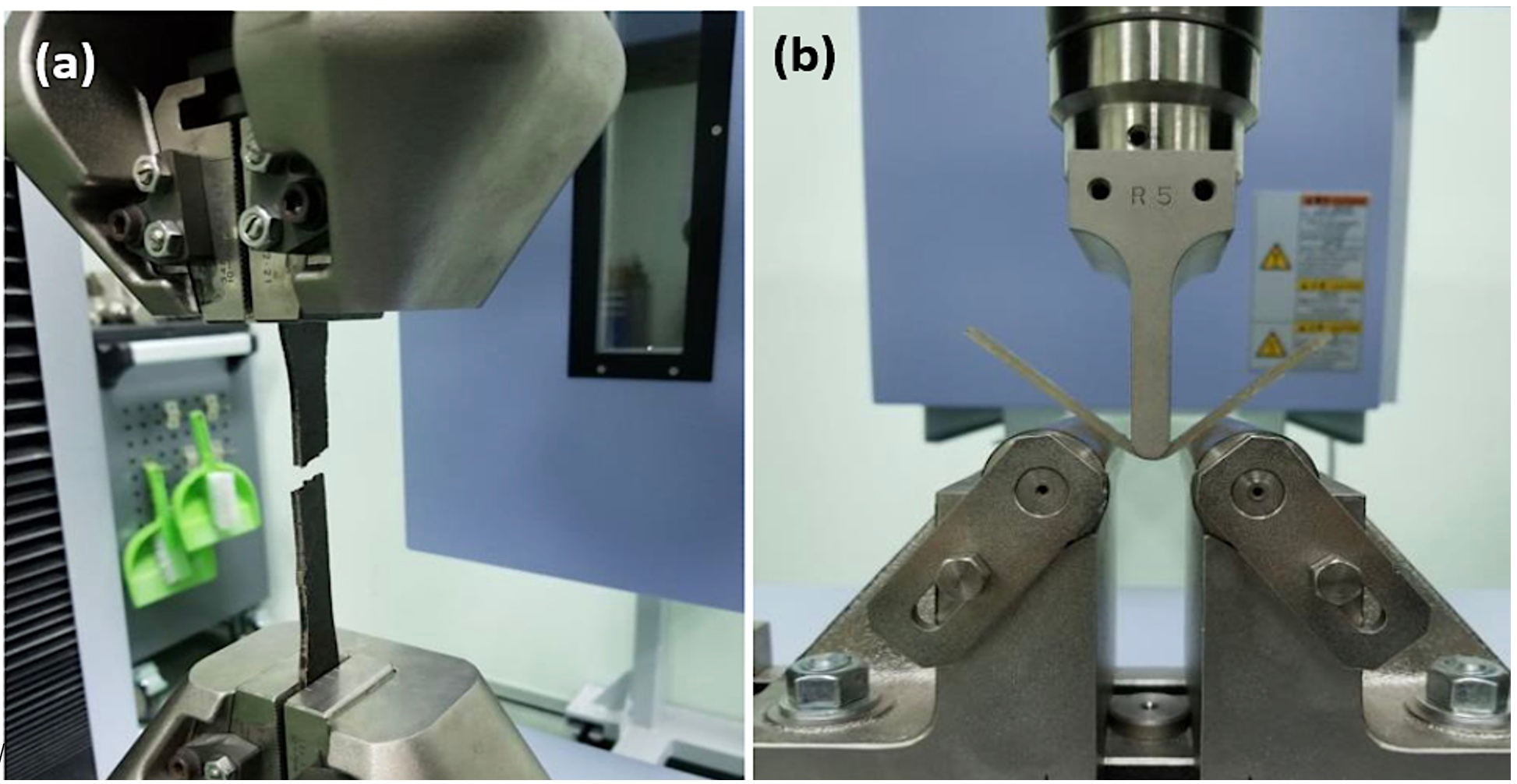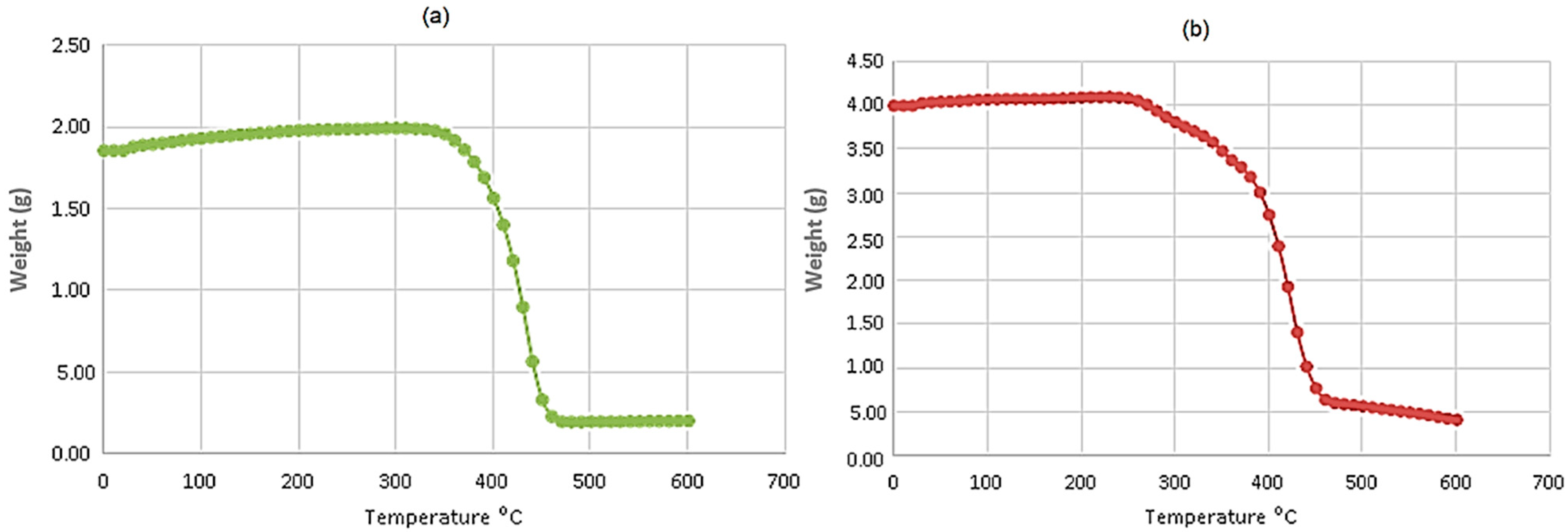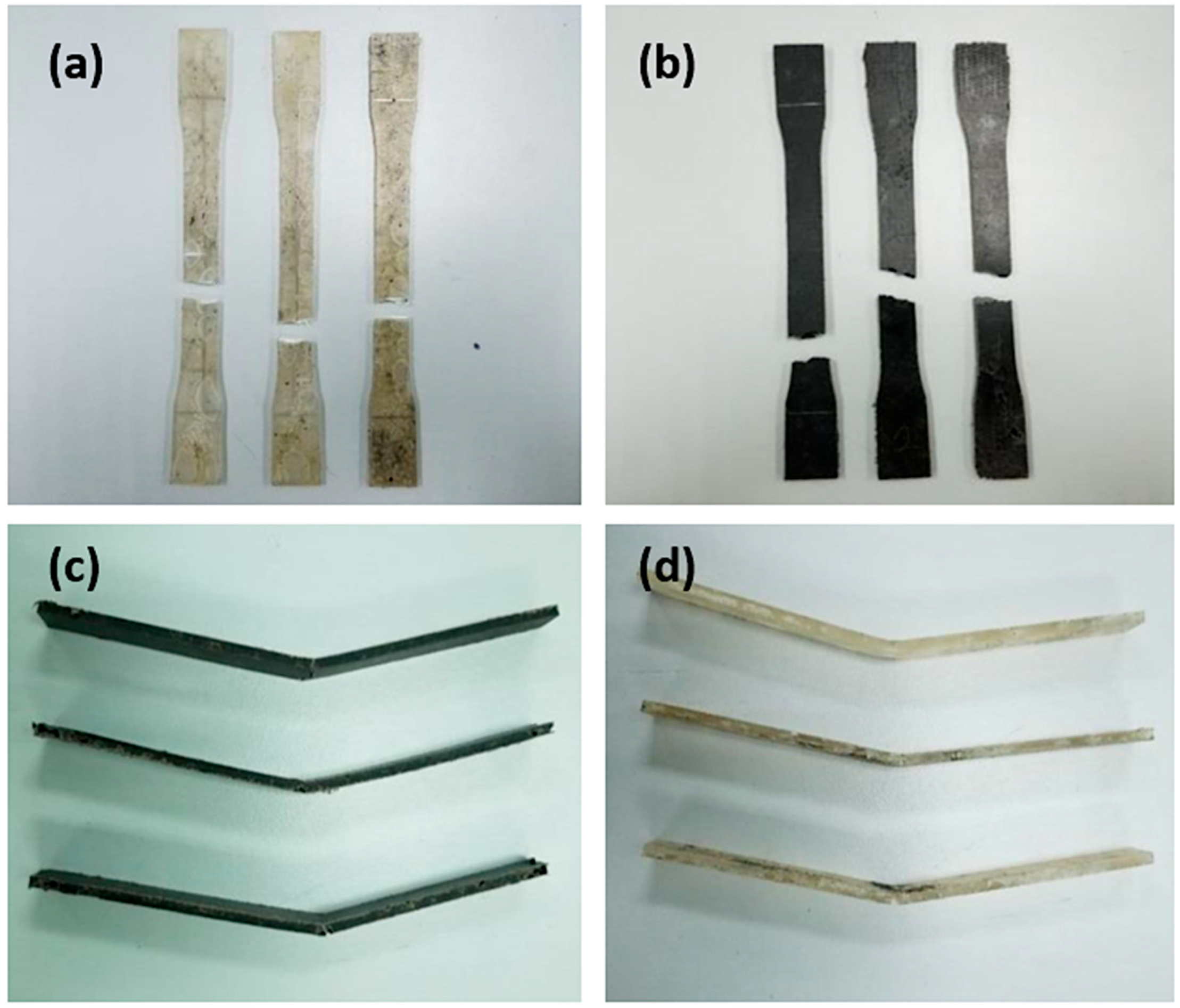Mechanical and Thermal Properties of Coconut (Cocos nucifera)-Reinforced Polypropylene Composite
Abstract
1. Introduction
2. Materials and Methods
2.1. Sample Preparation
2.2. Thermo-Gravimetric Analysis (TGA)
2.3. Mechanical Testing
2.4. Morphological Analysis
2.5. One-Way ANOVA
3. Results and Discussion
3.1. Thermo-Gravimetric Analysis (TGA)
3.2. Mechanical Properties
3.3. Analysis of Variance (ANOVA)
3.4. Scanning Electron Microscope (SEM)
4. Conclusions
Author Contributions
Funding
Institutional Review Board Statement
Informed Consent Statement
Data Availability Statement
Acknowledgments
Conflicts of Interest
Abbreviations
| CS | Coconut Shell |
| PP | Polypropylene |
| PLA | Poly(lactic acid) |
| EBA | Ethylene Butylene Acrylate |
| GMA | Glycidyl Methacrylate |
| TGA | Thermo-gravimetric Analysis |
| SEM | Scanning Electron Microscope |
| ANOVA | Analysis of Variance |
| AD | Anderson–Darling |
| GNP | Graphene Nanoplatelets |
References
- Gunasekaran, K.; Annadurai, R.; Kumar, P. Long term study on compressive and bond strength of coconut shell aggregate concrete. Constr. Build. Mater. 2012, 28, 208–215. [Google Scholar] [CrossRef]
- Zohary, D.; Hopf, M. Domestication of Plants in the Old World: The Origin and Spread of Cultivated Plants in West Asia, Europe and the Nile Valley, 3rd ed.; Oxford University Press: Oxford, UK, 2000. [Google Scholar]
- Nadzri, S.N.I.H.A.; Sultan, M.T.H.; Shah, A.U.M.; Safri, S.N.A.; Talib, A.R.A.; Jawaid, M.; Basri, A.A. A comprehensive review of coconut shell powder composites: Preparation, processing, and characterization. J. Thermoplast. Compos. Mater. 2022, 35, 2641–2664. [Google Scholar] [CrossRef]
- Matuana, L.M.; Balatinecz, J.J.; Park, C.B. Effect of surface properties on the adhesion between PVC and wood veneer laminates. Polym. Eng. Sci. 1998, 38, 765–773. [Google Scholar] [CrossRef]
- Mengeloglu, F.; Matuana, L.M.; King, J.A. Effects of impact modifiers on the properties of rigid PVC/wood-fiber composites. J. Vinyl Addit. Technol. 2000, 6, 153–157. [Google Scholar] [CrossRef]
- Clemons, C. Wood-plastic composites in the United States: The interfacing of two industries. For. Prod. J. 2002, 52, 10–18. [Google Scholar]
- Clemons, C. Elastomer modified polypropylene–polyethylene blends as matrices for wood flour–plastic composites. Compos. Part A Appl. Sci. Manuf. 2010, 41, 1559–1569. [Google Scholar] [CrossRef]
- Doss, R.M.; Muthuraj, R.; Parameswaran, M. Effect of Coconut Fiber Loading on the Morphological, Thermal, and Mechanical Properties of Coconut Fiber Reinforced Thermoplastic Starch/Beeswax Composites. Polymers 2023, 15, 875. [Google Scholar]
- Jha, P.; Mishra, D. Silanized Coconut Fiber Reinforced Poly (lactic acid) Composites: Interfacial Interaction, Crystallinity, and Thermomechanical Properties. J. Appl. Polym. Sci. 2023, 140, 52816. [Google Scholar]
- Keerthika, B.; Umayavalli, M.; Jeyalalitha, T.; Krishnaveni, N. Coconut shell powder as cost effective filler in copolymer of acrylonitrile and butadiene rubber. Ecotoxicol. Environ. Saf. 2016, 130, 1–3. [Google Scholar] [CrossRef]
- Okpala, C.; Chinwuko, E.; Ezeliora, C.; Awka, P.M.B. Mechanical properties and applications of coir fiber reinforced composites. Int. Res. J. Eng. Technol. 2021, 8. [Google Scholar] [CrossRef]
- Senthil Kumar, M.S.; Rajeshkumar, L.; Rangappa, S.M.; Siengchin, S. Mechanical behaviour analysis for banana/coir natural fiber hybrid epoxy composites through experimental modelling. J. Polym. Res. 2024, 31, 163. [Google Scholar] [CrossRef]
- Kumar, S.; Ramesh, K. Thermo-Mechanical Performance of 3D Printed Coir Fiber/PLA Biocomposites. Polym. Compos. 2024, 45, 2891–2901. [Google Scholar]
- Singh, S.; Kumar, R. Coir Fiber Reinforced Chemically Functionalized Ethylene Butylene Acrylate Composites: A Study on Mechanical and Thermal Properties. Polym. Eng. Sci. 2024, 64, 47–57. [Google Scholar]
- Islam, T.; Das, S.C.; Saha, J.; Paul, D.; Islam, M.T.; Rahman, M.; Khan, M.A. Effect of Coconut Shell Powder as Filler on the Mechanical Properties of Coir-polyester Composites. Chem. Mater. Eng. 2017, 5, 75–82. [Google Scholar] [CrossRef]
- Sumesh, K.R.; Kanthavel, K. Optimizing various parameters influencing mechanical properties of banana/coir natural fiber composites using grey relational analysis and artificial neural network models. J. Ind. Text. 2022, 51 (Suppl. S4), 6705S–6727S. [Google Scholar] [CrossRef]
- Costa, U.O.; Nascimento, L.F.C.; Garcia, J.M.; Bezerra, W.B.A.; Monteiro, S.N. Evaluation of Izod impact and bend properties of epoxy composites reinforced with mallow fibers. J. Mater. Res. Technol. 2020, 9, 373–382. [Google Scholar] [CrossRef]
- Mohanraj, C.M.; Rameshkumar, R.; Mariappan, M.; Mohankumar, A.; Rajendran, B.; Senthamaraikannan, P.; Suyambulingam, I.; Kumar, R. Recent Progress in Fiber Reinforced Polymer Hybrid Composites and Its Challenges-A Comprehensive Review. J. Nat. Fibers 2025, 22, 2495911. [Google Scholar] [CrossRef]
- Ahmad, M.N.; Mohamad, A.R. Analysis on dimensional accuracy of 3D printed parts by Taguchi approach. In Lecture Notes in Mechanical Engineering; Springer: Singapore, 2020; pp. 219–231. [Google Scholar] [CrossRef]
- Costa, U.O.; Garcia Filho, F.D.C.; Rio, T.G.D.; Rodrigues, J.G.P.; Simonassi, N.T.; Monteiro, S.N.; Nascimento, L.F.C. Mechanical properties optimization of hybrid aramid and jute fabrics-reinforced graphene nanoplatelets in functionalized HDPE matrix nanocomposites. Polymers 2023, 15, 2460. [Google Scholar] [CrossRef]
- Ahmad, M.N.; Ishak, M.R.; Taha, M.M.; Mustapha, F.; Leman, Z. Finite element analysis of oil palm fiber reinforced thermoplastic composites for fused deposition modeling. Mater. Today Proc. 2023, 74, 509–512. [Google Scholar] [CrossRef]
- ASTM D638-14; Standard Test Method for Tensile Properties of Plastics. ASTM International: West Conshohocken, PA, USA, 2022.
- ASTM D790-17; Standard test Methods for Flexural Properties of Unreinforced and Reinforced Plastics and Electrical Insulating Materials. ASTM International: West Conshohocken, PA, USA, 2017.
- Ahmad, M.N.; Ishak, M.R.; Taha, M.M.; Mustapha, F.; Leman, Z. Mechanical, thermal and physical characteristics of oil palm (Elaeis Guineensis) fiber reinforced thermoplastic composites for FDM–Type 3D printer. Polym. Test. 2023, 120, 107972. [Google Scholar] [CrossRef]
- Osman, M.A.; Atia, M.R. Investigation of ABS-rice straw composite feedstock filament for FDM. Rapid Prototyp. J. 2018, 24, 1067–1075. [Google Scholar] [CrossRef]
- Bledzki, A.K.; Mamun, A.A.; Volk, J. Barley husk and coconut shell reinforced polypropylene composites: The effect of fibre physical, chemical and surface properties. Compos. Sci. Technol. 2010, 70, 840–846. [Google Scholar] [CrossRef]
- Monteiro, S.N.; Terrones, L.A.H.; D’almeida, J.R.M. Mechanical performance of coir fiber/polyester composites. Polym. Test. 2008, 27, 591–595. [Google Scholar]
- Shrivastava, R.; Telang, A.; Rana, R.S.; Purohit, R. Mechanical properties of coir/glass fiber epoxy resin hybrid composite. Mater. Today Proc. 2017, 4, 3477–3483. [Google Scholar]
- Fuad, M.Y.; Ismail, Z.; Mansor, M.S.; Ishak, Z.A.; Omar, A.K. Mechanical properties of rice husk ash/polypropylene composites. Polym. J. 1995, 27, 1002–1015. [Google Scholar]
- Ezenkwaa, O.E.; Hassanb, A.; Samsudina, S.A. Tensile and Impact Properties of Rice Husk Filled Ethylene-Acrylic Ester Maleic Anhydride Compatibilized Polypropylene Composites. CET J.-Chem. Eng. Trans. 2021, 83, 511–516. [Google Scholar]
- Atuanya, C.U.; Olaitan, S.A.; Akagu, C.C.; Onukwuli, O.D.; Menkiti, M.C. Effect of rice husk filler on mechanical properties of polyethylene matrix composite. Int. J. Curr. Res. Rev. 2013, 5, 111–118. [Google Scholar]
- Bujjibabu, G.; Das, V.C.; Ramakrishna, M.; Nagarjuna, K. Development of Banana/Coir Natural Fibers Reinforced Polypropylene Hybrid Composites: The Effect of MA-g-PP (Maleic Anhydride Grafted Polypropylene) on Mechanical Properties and Thermal Properties. Nano Hybrids Compos. 2021, 32, 85–97. [Google Scholar]
- Nukala, S.G.; Kong, I.; Kakarla, A.B.; Tshai, K.Y.; Kong, W. Preparation and Characterisation of Wood Polymer Composites Using Sustainable Raw Materials. Polymers 2022, 14, 3183. [Google Scholar] [CrossRef]
- Guo, R.; Ren, Z.; Bi, H.; Song, Y.; Xu, M. Effect of toughening agents on the properties of poplar wood flour/poly (lactic acid) composites fabricated with Fused Deposition Modeling. Eur. Polym. J. 2018, 107, 34–45. [Google Scholar] [CrossRef]
- Neher, B.; Gafur, A.; Al-Mansur, M.A.; Bhuiyan, M.R.; Qadir, R.; Ahmed, F. Investigation of the Surface Morphology and Structural Characterization of Palm Fiber Reinforced Acrylonitrile Butadiene Styrene (PF-ABS) Composites. Mater. Sci. Appl. 2014, 05, 378–386. [Google Scholar] [CrossRef]
- Bi, H.; Ren, Z.; Guo, R.; Xu, M.; Song, Y. Fabrication of flexible wood flour/thermoplastic polyurethane elastomer composites using fused deposition molding. Ind. Crop. Prod. 2018, 122, 76–84. [Google Scholar] [CrossRef]
- Shahar, F.S.; Sultan, M.T.H.; Safri, S.N.A.; Jawaid, M.; Abu Talib, A.R.; Basri, A.A.; Shah, A.U.M. Physical, thermal and tensile behaviour of 3D printed kenaf/PLA to suggest its usability for ankle–foot orthosis—A preliminary study. Rapid Prototyp. J. 2022, 28, 1573–1588. [Google Scholar] [CrossRef]
- Obasi, H.C.; Mark, U.C.; Mark, U. Improving the mechanical properties of polypropylene composites with coconut shell particles. Compos. Adv. Mater. 2021, 30, 26349833211007497. [Google Scholar] [CrossRef]








| Response | Factor | DF | SS | MS | F | p |
|---|---|---|---|---|---|---|
| Tensile | Between groups | 1 | 55.8 | 55.8 | 0.75 | 0.043 * |
| Error | 4 | 299.1 | 74.8 | |||
| Total | 5 | 354.9 | ||||
| Tensile Modulus | Between groups | 1 | 0.88 | 0.88 | 0.81 | 0.041 * |
| Error | 4 | 4.35 | 1.09 | |||
| Total | 5 | 5.24 | ||||
| Flexural | Between groups | 1 | 58.9 | 58.9 | 0.84 | 0.041 * |
| Error | 4 | 279.5 | 69.9 | |||
| Total | 5 | 338.4 | ||||
| Flexural Modulus | Between groups | 1 | 10.935 | 10.935 | 21.03 | 0.010 * |
| Error | 4 | 2.080 | 0.520 | |||
| Total | 5 | 13.015 |
Disclaimer/Publisher’s Note: The statements, opinions and data contained in all publications are solely those of the individual author(s) and contributor(s) and not of MDPI and/or the editor(s). MDPI and/or the editor(s) disclaim responsibility for any injury to people or property resulting from any ideas, methods, instructions or products referred to in the content. |
© 2025 by the authors. Licensee MDPI, Basel, Switzerland. This article is an open access article distributed under the terms and conditions of the Creative Commons Attribution (CC BY) license (https://creativecommons.org/licenses/by/4.0/).
Share and Cite
Ahmad, M.N.; Puasa, M.N. Mechanical and Thermal Properties of Coconut (Cocos nucifera)-Reinforced Polypropylene Composite. Eng 2025, 6, 299. https://doi.org/10.3390/eng6110299
Ahmad MN, Puasa MN. Mechanical and Thermal Properties of Coconut (Cocos nucifera)-Reinforced Polypropylene Composite. Eng. 2025; 6(11):299. https://doi.org/10.3390/eng6110299
Chicago/Turabian StyleAhmad, Mohd Nazri, and Muhammad Nazrin Puasa. 2025. "Mechanical and Thermal Properties of Coconut (Cocos nucifera)-Reinforced Polypropylene Composite" Eng 6, no. 11: 299. https://doi.org/10.3390/eng6110299
APA StyleAhmad, M. N., & Puasa, M. N. (2025). Mechanical and Thermal Properties of Coconut (Cocos nucifera)-Reinforced Polypropylene Composite. Eng, 6(11), 299. https://doi.org/10.3390/eng6110299







